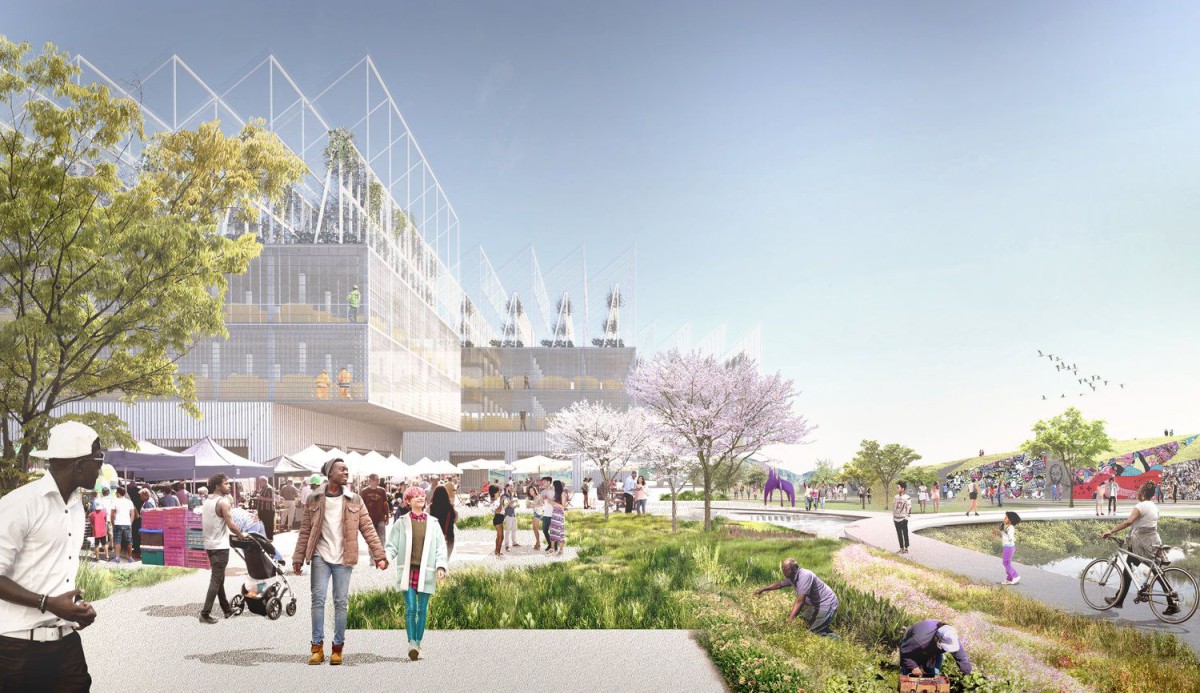BIG . ONE . SHERWOOD
Today, the basin of Islais Creek–an historic watershed-turned-industrial district in San Francisco, built on rubble from a 1906 earthquake–is at risk from coastal and stormwater flooding, as well as liquefaction.
Islais Hyper-Creek is a vision for the area where ecology and industry co-exist in harmony. A large park with a restored tidal creek system and soft shoreline shares the area with maritime functions, light manufacturing, and logistics that have formed the area’s economic backbone for decades. This park plays an important role in building physical and social resilience: it retains, conveys and cleans water, protecting the surrounding neighborhoods while providing amenities and benefits to the community. Present-day industrial functions are consolidated in a smaller area, clustered with complementary programs. This increases their efficiency and provides new economic opportunities.
Six proposed pilot projects, developed together with stakeholders and local communities, will kickstart a long-term process toward realizing the overall vision.
_
·
Islais Hyper-Creek is located at the juncture of many diverse neighborhoods, including Bayview-Hunters Point, Dogpatch, and Potrero Hill. Notably, the area is a nexus for working-class industrial jobs as well as food distribution, art-making, craftsmanship, fabrication, and more. The present-day Islais Creek is more channel than creek, though its low-lying surroundings were once marshland, now filled in with debris and at risk of liquefaction.
The area also faces the risks of stormwater and sewage flooding along with repeat coastal flooding. It functions as important infrastructural hub for the entire city, host to shipping centers, the city’s wholesale produce market, a wastewater treatment plant which treats 80% of San Francisco’s sewage, and many other supporting businesses in construction, manufacturing, and crafts. The area currently provides 22,000 jobs. If it were to come to a standstill because of catastrophic shock, the City of San Francisco would stop functioning.
The central element of Islais Hyper-Creek is a naturalized creek, its restored watershed absorbing millions of gallons of stormwater annually while providing multi-level ecosystem benefits. Public spaces along the swimmable riparian corridor offer recreational amenities, reconnecting the area to its historic waterfront.
Beyond the creek itself, Islais Hyper-Creek is a holistic, district-wide plan. Existing industrial operations in the nearby districts are clustered, consolidated, and intensified, creating a vital job and logistics hub dependent on the industrial economy. Infrastructure, including logistical and port functions, is strengthened and adapted to be both flood and earthquake-resistant. Weaving together natural, industrial, and social ecosystems, the creek becomes a dense, connective, and accessible area: a resilience model for the entire Bay Area.
Bringing resilient design to Islais Creek is a long-term vision but a short-term method to deal with the immediate shocks and stresses of climate change, which can be seen daily in the built and natural environment. Subject to king tides, repeat flooding, and sea level rise, the neighborhoods surrounding the present-day industrialized creek house an increasingly vulnerable hub of vital infrastructure for the City of San Francisco, as well as constituent jobs and cultural assets. At the same time, residents and local workers raise the issues of environmental justice and equitable access to training and jobs.
The BIG + ONE + Sherwood team recognizes the importance of adaptive scalar thinking accounting for both immediate risks and long-term strategies in the creation of an equitable, climate-responsive, and valuable series of public spaces and interventions. With Islais Hyper-Creek, the team proposes a strategy integrating protective and adaptive measures on the shoreline with ecological restoration and economic growth extending throughout the creek basin, while also fostering social resiliency and training programs further upland.
_


















